Analyzing Database Models and Data Storage Techniques
VerifiedAdded on 2020/05/28
|8
|2197
|342
Essay
AI Summary
The task involves comparing different database management systems (DBMS) with a focus on ERD, relational, and NoSQL models. Students are expected to explore how these models manage complex data structures, their use cases, and inherent advantages or disadvantages. The assignment will also delve into various data storage techniques, particularly the flat file DBMS approach, assessing its efficiency for big data scenarios. The objective is to provide a comprehensive understanding of modern database systems and their applications in business intelligence and data warehousing.
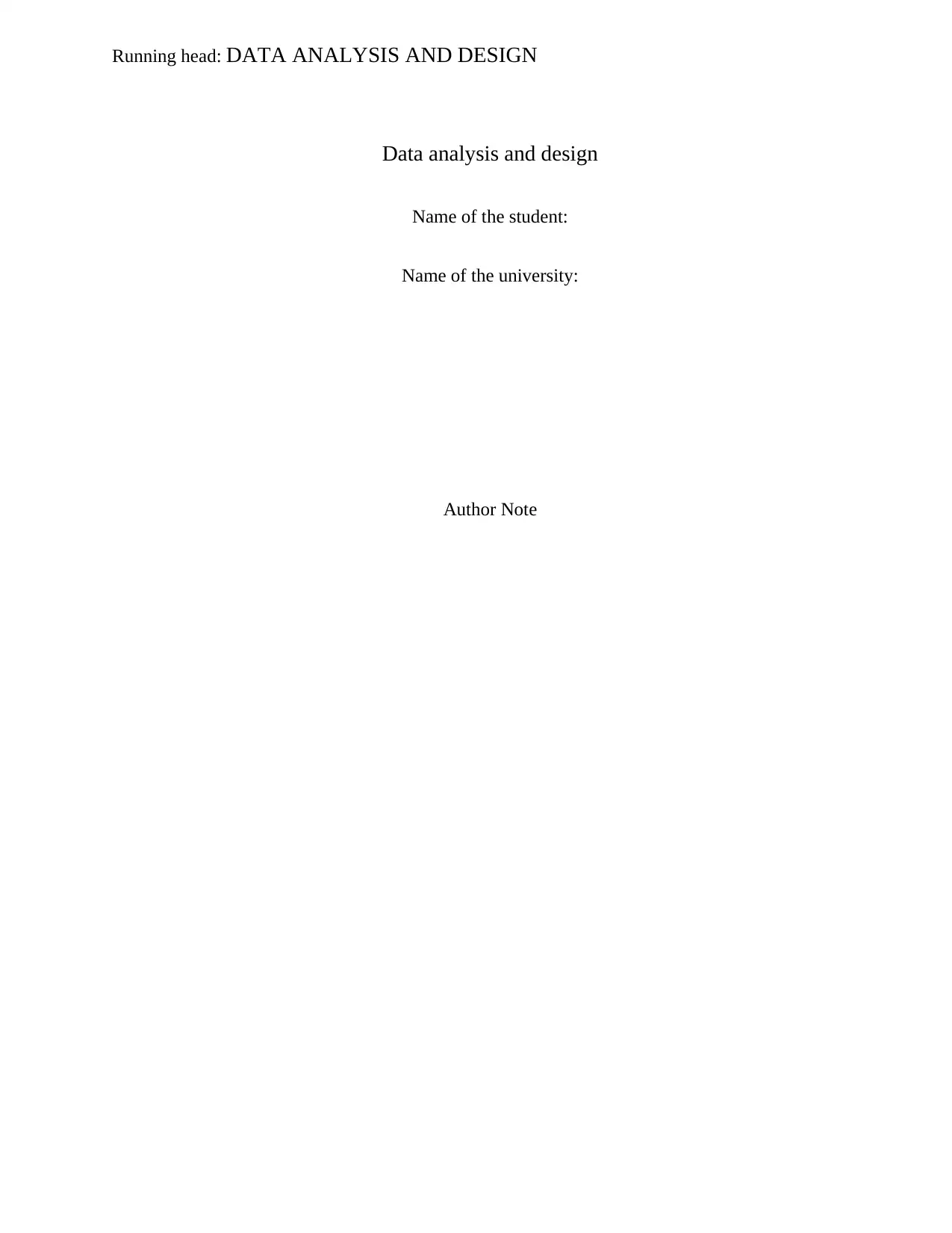
Running head: DATA ANALYSIS AND DESIGN
Data analysis and design
Name of the student:
Name of the university:
Author Note
Data analysis and design
Name of the student:
Name of the university:
Author Note
Paraphrase This Document
Need a fresh take? Get an instant paraphrase of this document with our AI Paraphraser
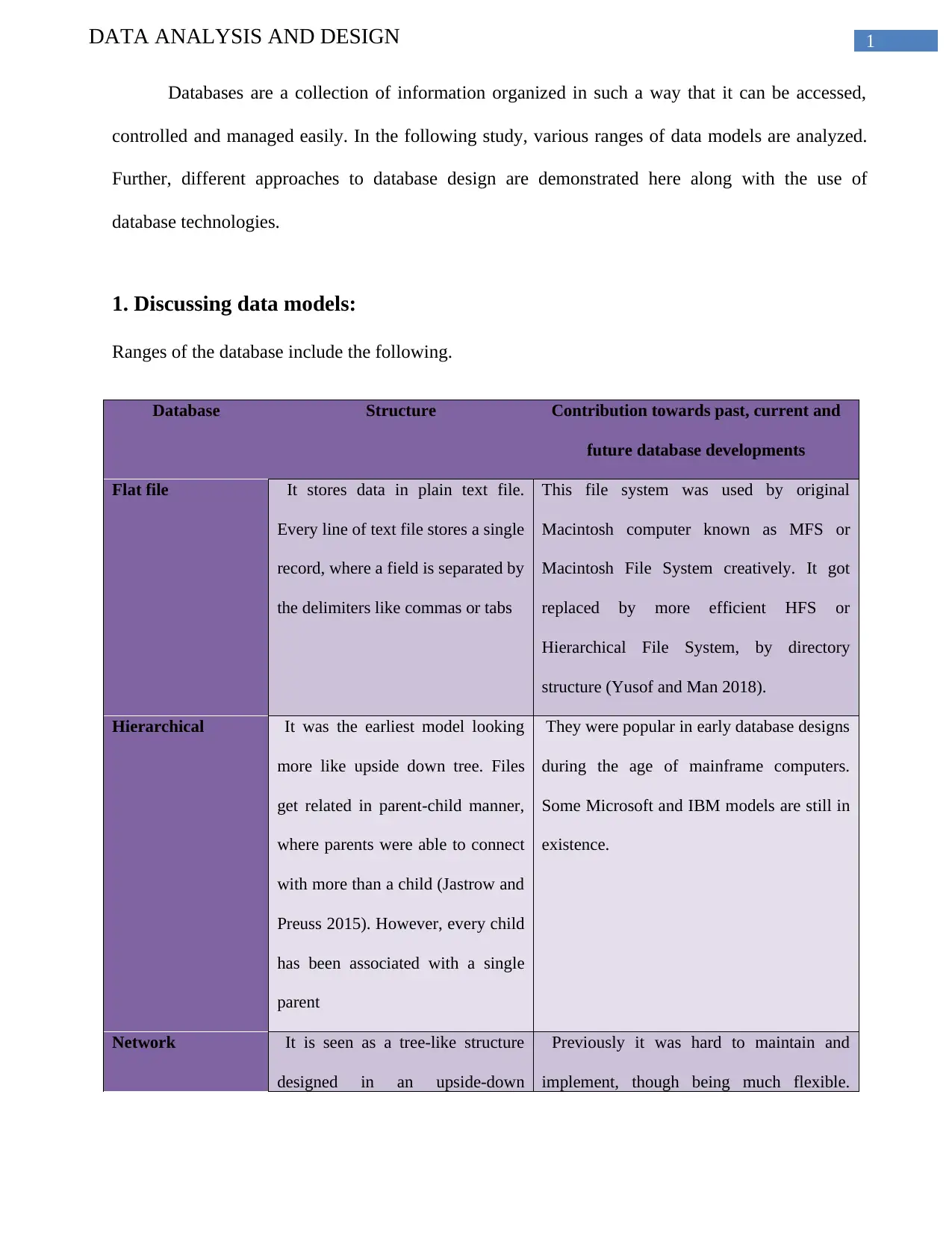
1DATA ANALYSIS AND DESIGN
Databases are a collection of information organized in such a way that it can be accessed,
controlled and managed easily. In the following study, various ranges of data models are analyzed.
Further, different approaches to database design are demonstrated here along with the use of
database technologies.
1. Discussing data models:
Ranges of the database include the following.
Database Structure Contribution towards past, current and
future database developments
Flat file It stores data in plain text file.
Every line of text file stores a single
record, where a field is separated by
the delimiters like commas or tabs
This file system was used by original
Macintosh computer known as MFS or
Macintosh File System creatively. It got
replaced by more efficient HFS or
Hierarchical File System, by directory
structure (Yusof and Man 2018).
Hierarchical It was the earliest model looking
more like upside down tree. Files
get related in parent-child manner,
where parents were able to connect
with more than a child (Jastrow and
Preuss 2015). However, every child
has been associated with a single
parent
They were popular in early database designs
during the age of mainframe computers.
Some Microsoft and IBM models are still in
existence.
Network It is seen as a tree-like structure
designed in an upside-down
Previously it was hard to maintain and
implement, though being much flexible.
Databases are a collection of information organized in such a way that it can be accessed,
controlled and managed easily. In the following study, various ranges of data models are analyzed.
Further, different approaches to database design are demonstrated here along with the use of
database technologies.
1. Discussing data models:
Ranges of the database include the following.
Database Structure Contribution towards past, current and
future database developments
Flat file It stores data in plain text file.
Every line of text file stores a single
record, where a field is separated by
the delimiters like commas or tabs
This file system was used by original
Macintosh computer known as MFS or
Macintosh File System creatively. It got
replaced by more efficient HFS or
Hierarchical File System, by directory
structure (Yusof and Man 2018).
Hierarchical It was the earliest model looking
more like upside down tree. Files
get related in parent-child manner,
where parents were able to connect
with more than a child (Jastrow and
Preuss 2015). However, every child
has been associated with a single
parent
They were popular in early database designs
during the age of mainframe computers.
Some Microsoft and IBM models are still in
existence.
Network It is seen as a tree-like structure
designed in an upside-down
Previously it was hard to maintain and
implement, though being much flexible.
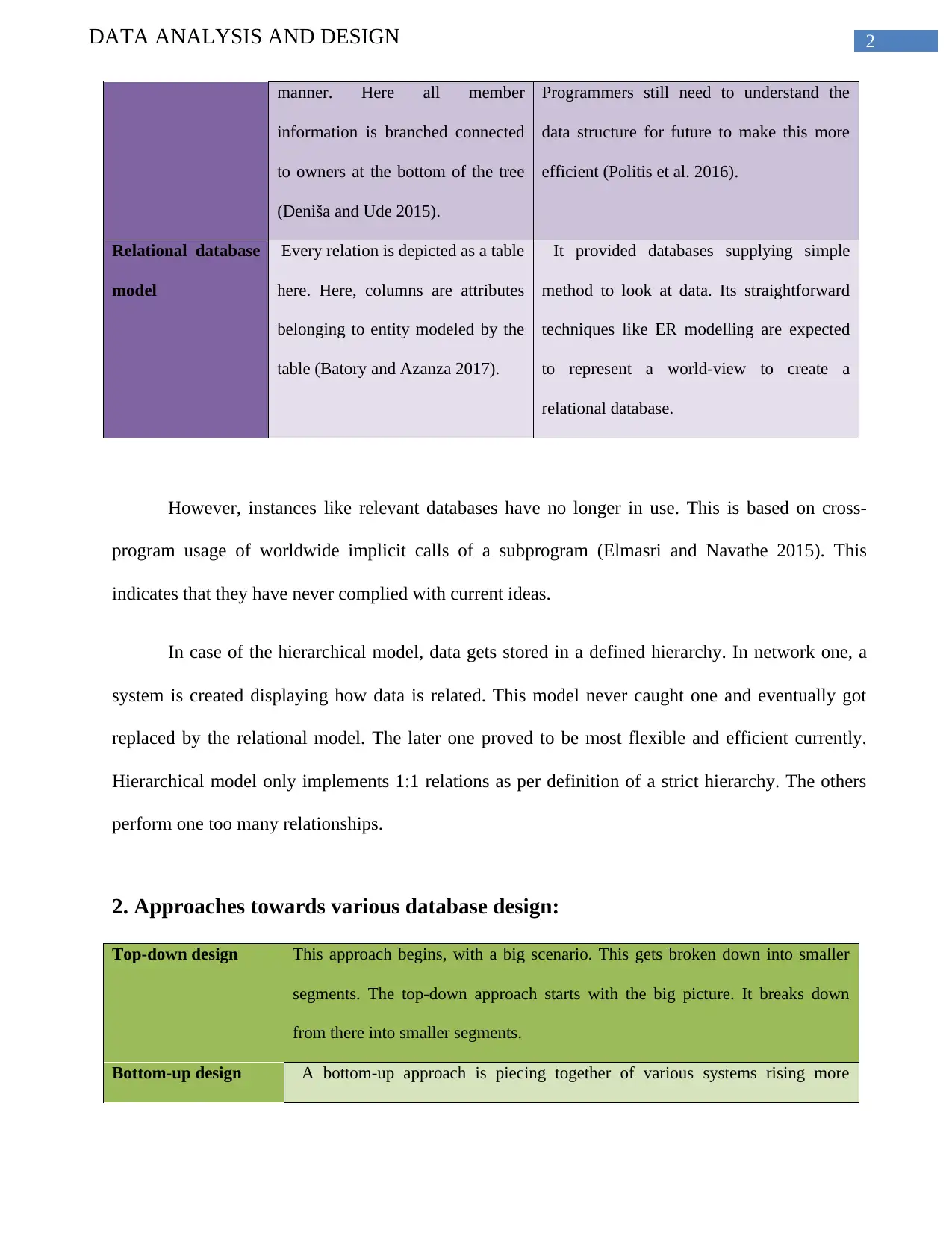
2DATA ANALYSIS AND DESIGN
manner. Here all member
information is branched connected
to owners at the bottom of the tree
(Deniša and Ude 2015).
Programmers still need to understand the
data structure for future to make this more
efficient (Politis et al. 2016).
Relational database
model
Every relation is depicted as a table
here. Here, columns are attributes
belonging to entity modeled by the
table (Batory and Azanza 2017).
It provided databases supplying simple
method to look at data. Its straightforward
techniques like ER modelling are expected
to represent a world-view to create a
relational database.
However, instances like relevant databases have no longer in use. This is based on cross-
program usage of worldwide implicit calls of a subprogram (Elmasri and Navathe 2015). This
indicates that they have never complied with current ideas.
In case of the hierarchical model, data gets stored in a defined hierarchy. In network one, a
system is created displaying how data is related. This model never caught one and eventually got
replaced by the relational model. The later one proved to be most flexible and efficient currently.
Hierarchical model only implements 1:1 relations as per definition of a strict hierarchy. The others
perform one too many relationships.
2. Approaches towards various database design:
Top-down design This approach begins, with a big scenario. This gets broken down into smaller
segments. The top-down approach starts with the big picture. It breaks down
from there into smaller segments.
Bottom-up design A bottom-up approach is piecing together of various systems rising more
manner. Here all member
information is branched connected
to owners at the bottom of the tree
(Deniša and Ude 2015).
Programmers still need to understand the
data structure for future to make this more
efficient (Politis et al. 2016).
Relational database
model
Every relation is depicted as a table
here. Here, columns are attributes
belonging to entity modeled by the
table (Batory and Azanza 2017).
It provided databases supplying simple
method to look at data. Its straightforward
techniques like ER modelling are expected
to represent a world-view to create a
relational database.
However, instances like relevant databases have no longer in use. This is based on cross-
program usage of worldwide implicit calls of a subprogram (Elmasri and Navathe 2015). This
indicates that they have never complied with current ideas.
In case of the hierarchical model, data gets stored in a defined hierarchy. In network one, a
system is created displaying how data is related. This model never caught one and eventually got
replaced by the relational model. The later one proved to be most flexible and efficient currently.
Hierarchical model only implements 1:1 relations as per definition of a strict hierarchy. The others
perform one too many relationships.
2. Approaches towards various database design:
Top-down design This approach begins, with a big scenario. This gets broken down into smaller
segments. The top-down approach starts with the big picture. It breaks down
from there into smaller segments.
Bottom-up design A bottom-up approach is piecing together of various systems rising more
⊘ This is a preview!⊘
Do you want full access?
Subscribe today to unlock all pages.

Trusted by 1+ million students worldwide
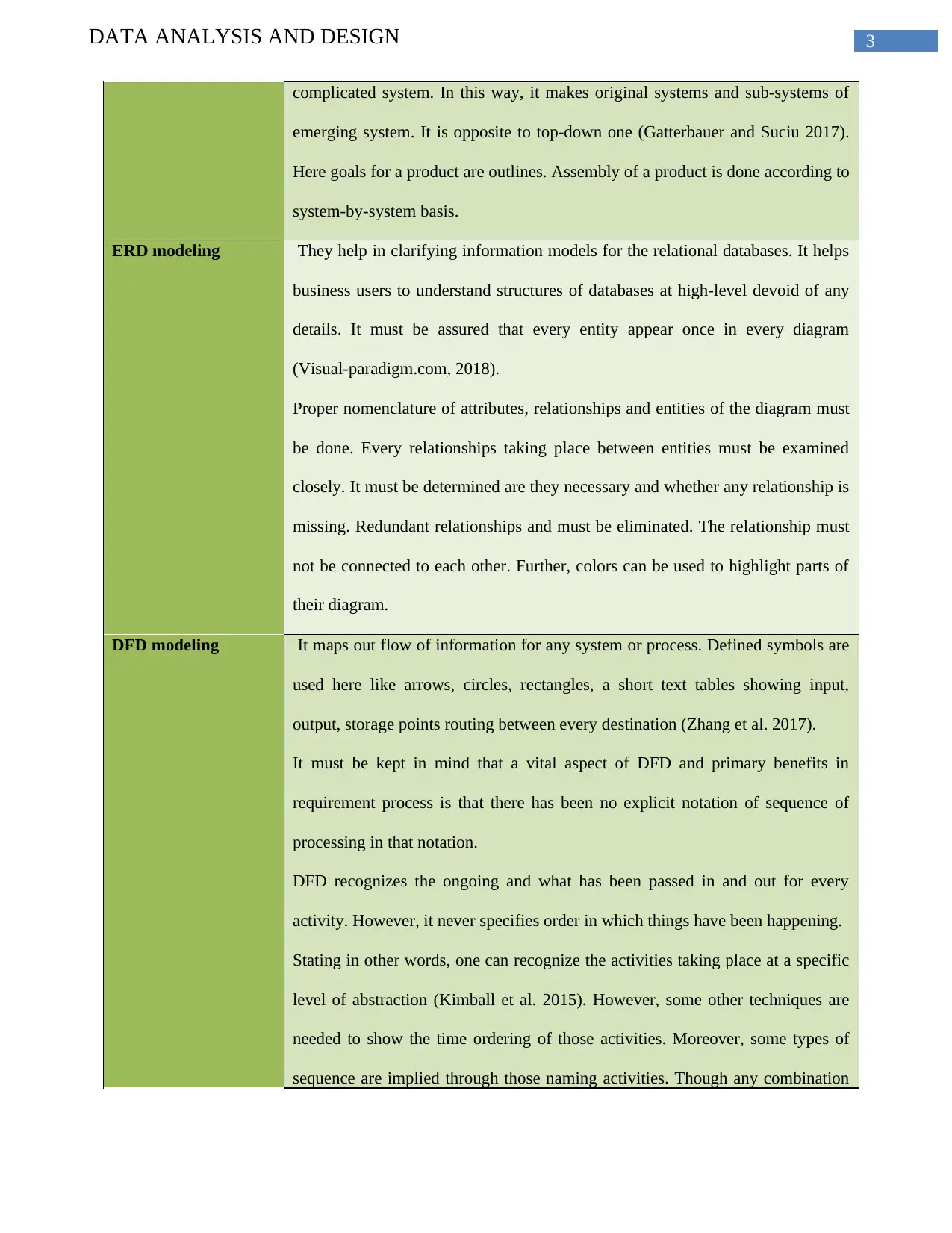
3DATA ANALYSIS AND DESIGN
complicated system. In this way, it makes original systems and sub-systems of
emerging system. It is opposite to top-down one (Gatterbauer and Suciu 2017).
Here goals for a product are outlines. Assembly of a product is done according to
system-by-system basis.
ERD modeling They help in clarifying information models for the relational databases. It helps
business users to understand structures of databases at high-level devoid of any
details. It must be assured that every entity appear once in every diagram
(Visual-paradigm.com, 2018).
Proper nomenclature of attributes, relationships and entities of the diagram must
be done. Every relationships taking place between entities must be examined
closely. It must be determined are they necessary and whether any relationship is
missing. Redundant relationships and must be eliminated. The relationship must
not be connected to each other. Further, colors can be used to highlight parts of
their diagram.
DFD modeling It maps out flow of information for any system or process. Defined symbols are
used here like arrows, circles, rectangles, a short text tables showing input,
output, storage points routing between every destination (Zhang et al. 2017).
It must be kept in mind that a vital aspect of DFD and primary benefits in
requirement process is that there has been no explicit notation of sequence of
processing in that notation.
DFD recognizes the ongoing and what has been passed in and out for every
activity. However, it never specifies order in which things have been happening.
Stating in other words, one can recognize the activities taking place at a specific
level of abstraction (Kimball et al. 2015). However, some other techniques are
needed to show the time ordering of those activities. Moreover, some types of
sequence are implied through those naming activities. Though any combination
complicated system. In this way, it makes original systems and sub-systems of
emerging system. It is opposite to top-down one (Gatterbauer and Suciu 2017).
Here goals for a product are outlines. Assembly of a product is done according to
system-by-system basis.
ERD modeling They help in clarifying information models for the relational databases. It helps
business users to understand structures of databases at high-level devoid of any
details. It must be assured that every entity appear once in every diagram
(Visual-paradigm.com, 2018).
Proper nomenclature of attributes, relationships and entities of the diagram must
be done. Every relationships taking place between entities must be examined
closely. It must be determined are they necessary and whether any relationship is
missing. Redundant relationships and must be eliminated. The relationship must
not be connected to each other. Further, colors can be used to highlight parts of
their diagram.
DFD modeling It maps out flow of information for any system or process. Defined symbols are
used here like arrows, circles, rectangles, a short text tables showing input,
output, storage points routing between every destination (Zhang et al. 2017).
It must be kept in mind that a vital aspect of DFD and primary benefits in
requirement process is that there has been no explicit notation of sequence of
processing in that notation.
DFD recognizes the ongoing and what has been passed in and out for every
activity. However, it never specifies order in which things have been happening.
Stating in other words, one can recognize the activities taking place at a specific
level of abstraction (Kimball et al. 2015). However, some other techniques are
needed to show the time ordering of those activities. Moreover, some types of
sequence are implied through those naming activities. Though any combination
Paraphrase This Document
Need a fresh take? Get an instant paraphrase of this document with our AI Paraphraser
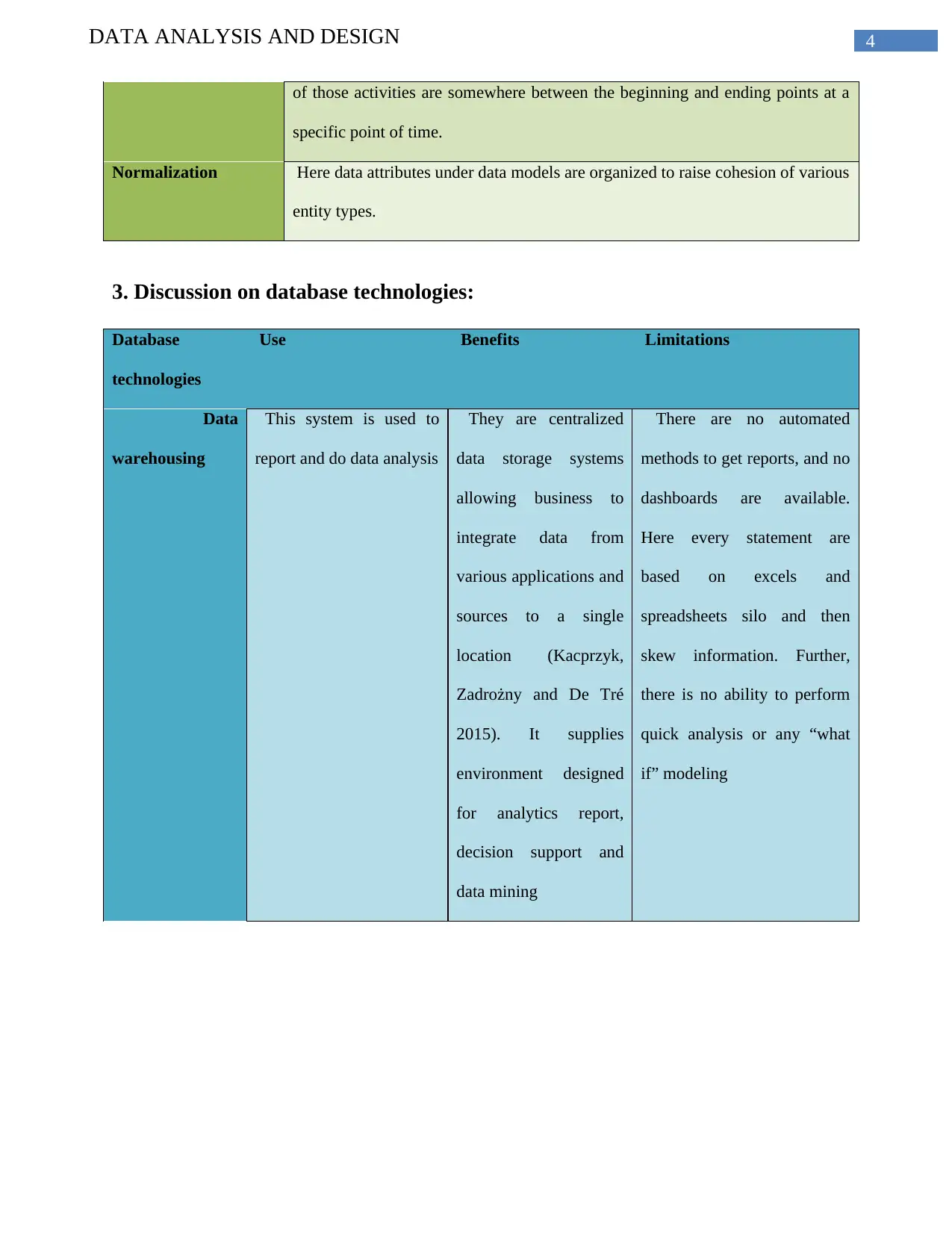
4DATA ANALYSIS AND DESIGN
of those activities are somewhere between the beginning and ending points at a
specific point of time.
Normalization Here data attributes under data models are organized to raise cohesion of various
entity types.
3. Discussion on database technologies:
Database
technologies
Use Benefits Limitations
Data
warehousing
This system is used to
report and do data analysis
They are centralized
data storage systems
allowing business to
integrate data from
various applications and
sources to a single
location (Kacprzyk,
Zadrożny and De Tré
2015). It supplies
environment designed
for analytics report,
decision support and
data mining
There are no automated
methods to get reports, and no
dashboards are available.
Here every statement are
based on excels and
spreadsheets silo and then
skew information. Further,
there is no ability to perform
quick analysis or any “what
if” modeling
of those activities are somewhere between the beginning and ending points at a
specific point of time.
Normalization Here data attributes under data models are organized to raise cohesion of various
entity types.
3. Discussion on database technologies:
Database
technologies
Use Benefits Limitations
Data
warehousing
This system is used to
report and do data analysis
They are centralized
data storage systems
allowing business to
integrate data from
various applications and
sources to a single
location (Kacprzyk,
Zadrożny and De Tré
2015). It supplies
environment designed
for analytics report,
decision support and
data mining
There are no automated
methods to get reports, and no
dashboards are available.
Here every statement are
based on excels and
spreadsheets silo and then
skew information. Further,
there is no ability to perform
quick analysis or any “what
if” modeling
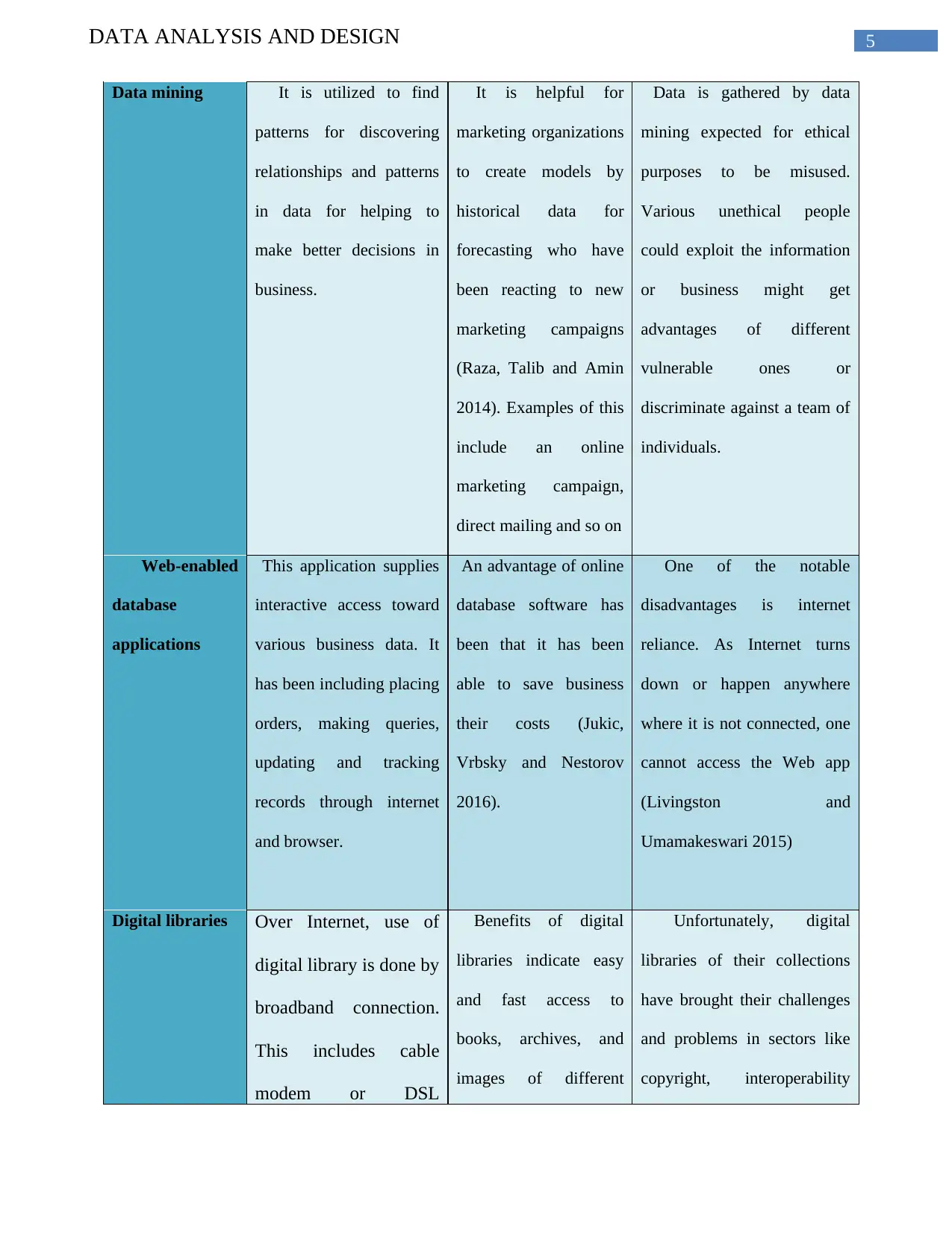
5DATA ANALYSIS AND DESIGN
Data mining It is utilized to find
patterns for discovering
relationships and patterns
in data for helping to
make better decisions in
business.
It is helpful for
marketing organizations
to create models by
historical data for
forecasting who have
been reacting to new
marketing campaigns
(Raza, Talib and Amin
2014). Examples of this
include an online
marketing campaign,
direct mailing and so on
Data is gathered by data
mining expected for ethical
purposes to be misused.
Various unethical people
could exploit the information
or business might get
advantages of different
vulnerable ones or
discriminate against a team of
individuals.
Web-enabled
database
applications
This application supplies
interactive access toward
various business data. It
has been including placing
orders, making queries,
updating and tracking
records through internet
and browser.
An advantage of online
database software has
been that it has been
able to save business
their costs (Jukic,
Vrbsky and Nestorov
2016).
One of the notable
disadvantages is internet
reliance. As Internet turns
down or happen anywhere
where it is not connected, one
cannot access the Web app
(Livingston and
Umamakeswari 2015)
Digital libraries Over Internet, use of
digital library is done by
broadband connection.
This includes cable
modem or DSL
Benefits of digital
libraries indicate easy
and fast access to
books, archives, and
images of different
Unfortunately, digital
libraries of their collections
have brought their challenges
and problems in sectors like
copyright, interoperability
Data mining It is utilized to find
patterns for discovering
relationships and patterns
in data for helping to
make better decisions in
business.
It is helpful for
marketing organizations
to create models by
historical data for
forecasting who have
been reacting to new
marketing campaigns
(Raza, Talib and Amin
2014). Examples of this
include an online
marketing campaign,
direct mailing and so on
Data is gathered by data
mining expected for ethical
purposes to be misused.
Various unethical people
could exploit the information
or business might get
advantages of different
vulnerable ones or
discriminate against a team of
individuals.
Web-enabled
database
applications
This application supplies
interactive access toward
various business data. It
has been including placing
orders, making queries,
updating and tracking
records through internet
and browser.
An advantage of online
database software has
been that it has been
able to save business
their costs (Jukic,
Vrbsky and Nestorov
2016).
One of the notable
disadvantages is internet
reliance. As Internet turns
down or happen anywhere
where it is not connected, one
cannot access the Web app
(Livingston and
Umamakeswari 2015)
Digital libraries Over Internet, use of
digital library is done by
broadband connection.
This includes cable
modem or DSL
Benefits of digital
libraries indicate easy
and fast access to
books, archives, and
images of different
Unfortunately, digital
libraries of their collections
have brought their challenges
and problems in sectors like
copyright, interoperability
⊘ This is a preview!⊘
Do you want full access?
Subscribe today to unlock all pages.

Trusted by 1+ million students worldwide

6DATA ANALYSIS AND DESIGN
(Andrews 2017).
Various Dial up
connections are used for
accessing plain-text
documents and
documents that contain
images. However, fore
complex files and
animated video
contents, downstream
speed of minimum 100
Kbps makes user
experience less tedious
and much more
informative
(Dl.sciencesocieties.org,
2018). In this way
digital libraries are used
to update internet-based
libraries regularly.
kinds that are currently
identified by various
commercial interests
and numerous public
bodies alike
between software and systems
and interface design (Taheri et
al. 2015). Then there is equity
of access, digital preservation,
and copyright and user
authentication for access to
different collections.
Thus, the above study shows that data models have been efficiently capturing and reflecting
the state of business requirements. Further database designing has been providing a detailed data
(Andrews 2017).
Various Dial up
connections are used for
accessing plain-text
documents and
documents that contain
images. However, fore
complex files and
animated video
contents, downstream
speed of minimum 100
Kbps makes user
experience less tedious
and much more
informative
(Dl.sciencesocieties.org,
2018). In this way
digital libraries are used
to update internet-based
libraries regularly.
kinds that are currently
identified by various
commercial interests
and numerous public
bodies alike
between software and systems
and interface design (Taheri et
al. 2015). Then there is equity
of access, digital preservation,
and copyright and user
authentication for access to
different collections.
Thus, the above study shows that data models have been efficiently capturing and reflecting
the state of business requirements. Further database designing has been providing a detailed data
Paraphrase This Document
Need a fresh take? Get an instant paraphrase of this document with our AI Paraphraser

7DATA ANALYSIS AND DESIGN
model for databases. It has comprised of required physical and logical designing choices and
parameters of physical storage. The various database technologies demonstrated has been able to
access and update information efficiently and quickly as shown in the report.
model for databases. It has comprised of required physical and logical designing choices and
parameters of physical storage. The various database technologies demonstrated has been able to
access and update information efficiently and quickly as shown in the report.
1 out of 8
Related Documents
Your All-in-One AI-Powered Toolkit for Academic Success.
+13062052269
info@desklib.com
Available 24*7 on WhatsApp / Email
![[object Object]](/_next/static/media/star-bottom.7253800d.svg)
Unlock your academic potential
Copyright © 2020–2025 A2Z Services. All Rights Reserved. Developed and managed by ZUCOL.




